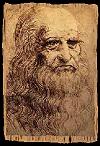|
|

The drawing
shown in gold on the left-hand side of all menus on this Web
site is the only known authentic
likeness and true self-portrait of the artist. Over this drawing
there is no dispute with Leonardo thought to have drawn it in
1512, when he was 50 and living in France. It is now held in
the magnificent collection of the Biblioteca Reale, Turin.
There
exist several other drawings and paintings, both by other people
and by Leonardo himself, which may or may not be true likenesses.
There is much debate over
whether or not the presumed
self-portraits are of Leonardo and at this time we do not have
the needed information to make definitive determinations. The
drawings under consideration as possible self-portraits are
as follows:
- A sketch showing
an Old Man Sitting on the banks of the Loire,
apparently deep in thought. It is among the works
of the Royal Collection at Windsor Castle.
- The cartoon
for Adoration of the Magi contains a young shepherd
boy. Off to the extreme right and completely isolated
from the rest of the painting in that he faces away
from the rest of the maddening crowd. It is thought
this may be the only ever self-portrait of a young
Leonardo and be based on a bronze statue in which he
posed for his master Verrocchio. At this time in history
it was usual for artists to include themselves in their
works and this same thing can be found with many artists
from the period.
- Drawing of an
old man, his hair in braided pigtails and turned to
the right. It is also possible that this sketch was
the study for a doctor in the painting Christ Disputing
with the Doctors.
Leonardo may have painted such a picture for Isabella
d' Este about 1504, but it is now lost to us.
- Mathematician
Fra Luca Pacioli wrote a book called "On
Divine Proportion". This contains a very simple
likely self-portrait of Leonardo, who was responsible
for illustrating the volume.
- The Geemente
Museum in Amsterdam holds a sketch also presumed to
be a self-portrait.
- Yet another
is held by Pinacoteca Ambrosiana in Milan. This shows
Leonardo facing towards the left and has his name beneath
the drawing.
- At what would
seem to be the most unlikely end of the scale, a few
experts consider Portrait of a Warrior may be
a self-portrait. It is more likely that work is modelled
after one of Verrocchio's bronze reliefs, or his equestrian
monument of Colleoni.
- More important
is the belief that Leonardo used his own face in several
studies of the proportions of the human face.
There
are also a number of portraits and paintings done by other artists
which are thought to be of, or include, Leonardo. The better-known
works are documented here:
- The Uffizi Gallery
contains two paintings presumed to be of Leonardo, but
he was not the artist in either case. The most important
of these paintings has been in the collection of the
Uffizi Gallery for almost two hundred years. Until very
recently it was considered to be a self-portrait and
the Gallery inventory from 1753 lists it as by Leonardo
himself. Scholars had been questioning this information
for around fifty years and the advent of radiographic
examination confirmed their suspicions. Beneath the
top painting is another one showing a repentant woman,
book and cross beside her and hands clasped to her breast.
After examination of this painting experts concluded
that it came from an unknown seventeenth century artist.
The over-painted portrait of Leonardo was probably carried
out some time towards the end of the 1600's and may
have been based upon the famous self-portrait housed
in Turin.
- Leonardo may
possibly have provided the model for Verrocchio's bronze
of a Young David.
- Italian painter
Raphael depicted Leonardo as the Greek philosopher Plato
in his famed work School of Athens. This was
somewhat ironic since Greek and Latin were two languages
Leonardo never mastered, despite making many attempts.
The painting shows Plato holding his Timaeus
while beside him stands Aristotle with his Ethics.
- It is thought
the figure of St. Michael from Francesco Botticini's
Tobias and the Archangels is a likeness of Leonardo.
He would have been about eighteen when the picture was
executed.
|
|

